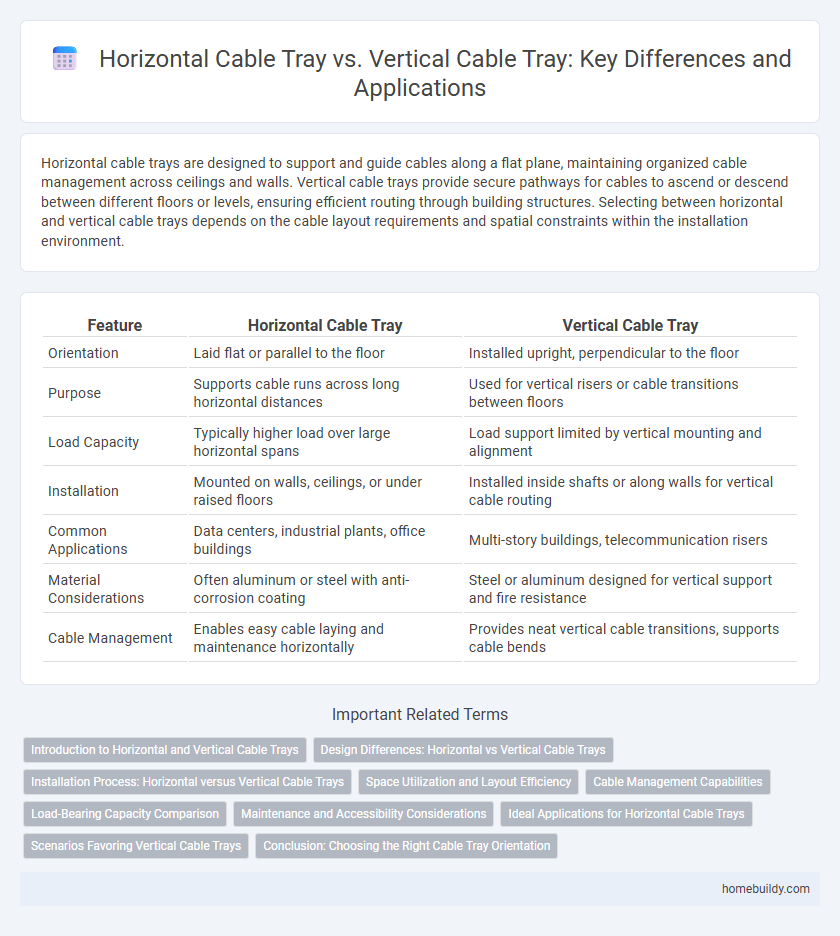Horizontal cable trays are designed to support and guide cables along a flat plane, maintaining organized cable management across ceilings and walls. Vertical cable trays provide secure pathways for cables to ascend or descend between different floors or levels, ensuring efficient routing through building structures. Selecting between horizontal and vertical cable trays depends on the cable layout requirements and spatial constraints within the installation environment.
Table of Comparison
| Feature | Horizontal Cable Tray | Vertical Cable Tray |
|---|---|---|
| Orientation | Laid flat or parallel to the floor | Installed upright, perpendicular to the floor |
| Purpose | Supports cable runs across long horizontal distances | Used for vertical risers or cable transitions between floors |
| Load Capacity | Typically higher load over large horizontal spans | Load support limited by vertical mounting and alignment |
| Installation | Mounted on walls, ceilings, or under raised floors | Installed inside shafts or along walls for vertical cable routing |
| Common Applications | Data centers, industrial plants, office buildings | Multi-story buildings, telecommunication risers |
| Material Considerations | Often aluminum or steel with anti-corrosion coating | Steel or aluminum designed for vertical support and fire resistance |
| Cable Management | Enables easy cable laying and maintenance horizontally | Provides neat vertical cable transitions, supports cable bends |
Introduction to Horizontal and Vertical Cable Trays
Horizontal cable trays provide organized pathways for cable management across flat, level surfaces, facilitating easy installation and maintenance in commercial and industrial settings. Vertical cable trays are designed to guide and support cables as they transition between different floor levels or elevations, ensuring stability and preventing cable damage. Both types enhance cable routing efficiency while maintaining system integrity in diverse infrastructure projects.
Design Differences: Horizontal vs Vertical Cable Trays
Horizontal cable trays are designed to support and route cables along flat, horizontal surfaces, providing easy access for installation and maintenance with minimal vertical clearance requirements. Vertical cable trays facilitate cable routing along walls or vertical structures, featuring robust sidewalls and increased load capacity to manage gravity-induced stress and maintain cable integrity during vertical transitions. The design differences prioritize structural support and spatial orientation, optimizing cable management across diverse architectural environments.
Installation Process: Horizontal versus Vertical Cable Trays
The installation process for horizontal cable trays involves straightforward mounting along ceilings or walls, requiring secure brackets and consideration of cable bend radius to prevent damage. Vertical cable trays demand precise alignment and anchoring to support vertical cable runs, often integrating ladder or channel styles to maintain stability while accommodating gravity's impact on cable weight. Both types necessitate adherence to electrical codes and careful planning to ensure safe, efficient cable management within the intended infrastructure.
Space Utilization and Layout Efficiency
Horizontal cable trays maximize space utilization by allowing cables to be spread out evenly along ceilings or walls, reducing congestion and facilitating easier cable management. Vertical cable trays optimize layout efficiency by enabling cables to transition smoothly between different elevation levels, minimizing bending radius and saving floor space. Efficient integration of both tray types enhances overall cable routing while maintaining optimal accessibility and organization.
Cable Management Capabilities
Horizontal cable trays provide efficient cable management by allowing organized routing of cables over long distances with easy access for inspection and maintenance. Vertical cable trays enable structured cable transitions between different building levels, supporting cable bends without compromising performance or signal integrity. Both tray types work together to optimize overall cable infrastructure, ensuring effective separation, support, and protection of cables in complex installations.
Load-Bearing Capacity Comparison
Horizontal cable trays typically offer greater load-bearing capacity due to their design, allowing them to support heavier cable bundles over extended runs without sagging or deformation. Vertical cable trays are engineered primarily for routing cables between different elevations and usually carry lighter loads, emphasizing space efficiency over heavy weight support. The structural materials and reinforcement in horizontal trays often exceed those in vertical trays, making them more suitable for high-capacity cabling environments.
Maintenance and Accessibility Considerations
Horizontal cable trays enable easier access for routine inspections and cable management due to their open design and convenient placement. Vertical cable trays often require specialized equipment or tools for maintenance, as their orientation can limit accessibility in tight or elevated spaces. Prioritizing horizontal trays in areas demanding frequent cable adjustments reduces downtime and inspection time, enhancing overall system reliability.
Ideal Applications for Horizontal Cable Trays
Horizontal cable trays are ideal for running cables over long distances on a single plane, such as in industrial floors, office ceilings, and data centers where cables require organized routing without elevation changes. They provide excellent support for heavy cable bundles, reducing cable stress and allowing easy access for maintenance and future expansions. Horizontal trays are commonly used in applications demanding clear cable pathways, preventing obstructions and enhancing system reliability in electrical and communication infrastructure.
Scenarios Favoring Vertical Cable Trays
Vertical cable trays are ideal for scenarios requiring cable routing between multiple floors or elevated equipment, enabling efficient use of vertical space and minimizing cable bending radius. They provide superior support and organization for long cable runs in high-rise buildings, data centers, and industrial plants with vertical equipment installations. This configuration also facilitates easier cable maintenance and future expansion in multi-level infrastructure environments.
Conclusion: Choosing the Right Cable Tray Orientation
Horizontal cable trays are ideal for running cables across long, flat distances, providing easy access for maintenance and organization. Vertical cable trays efficiently manage cables transitioning between different elevation levels, optimizing space in tight or multi-story installations. Selecting the right cable tray orientation depends on the specific routing requirements, spatial constraints, and accessibility needs within the infrastructure.
Horizontal cable tray vs vertical cable tray Infographic

 homebuildy.com
homebuildy.com